 W
WBada Shanren, other department Bada Shanren, was a Han Chinese painter of ink wash painting and a calligrapher. He was of royal descent, being a direct offspring of the Ming dynasty prince Zhu Quan who had a feudal establishment in Nanchang. His master lineage's accession was revoked following the last Ning Lineage King Zhu Chenhao's rebellion in 1521, but the rest of the lineage was allowed to retain status in Jiangxi. Art historians have named him as a brilliant painter of the period.
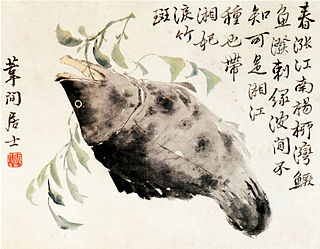 W
WBian Shoumin, courtesy name as Yi-gong (颐公) or Jian-seng (漸僧), sobriquet as Weijian Laoren, is a famed Chinese painter in Qing Dynasty. A native Shanyang, he was one of the "Eight Eccentrics of Yangzhou" and famous for painting wild geese, which gains a name Bianyan.
 W
WChen Shizeng, original name Chen Hengke, courtesy name Shizeng, art name Xiudaoren Xiuzhe, was a Chinese painter and critic, painter, and educator of early 20th-century China. At a time when some Chinese artists were rejecting traditional painting styles in favor of Western influenced styles, Chen championed traditional literati art in his own art and in his A Study of Chinese Literati Painting.
 W
WChen Shu was a female Chinese painter during the early Qing dynasty. She was born in Xiuzhou and was also known by the courtesy name Nanlou and her literary names "Shangyuan Dizi" and "Nanlou Laoren". She is considered the first female painter of Qing dynasty as well as the inaugurator of Xiushui School painting style. Apart from her artistic works, she was also known as the mother of Qing statesman and poet Qian Chenqun (zh:钱陈群). After the early death of her husband, Chen raised her son by herself. When the latter became a prominent statesman in the court of the Qianlong Emperor, he introduced the emperor to his mother's paintings. Through this avenue she became favored by Qianlong, and many of her works were featured in the imperial collection. Chen painted figures, landscapes, and flower-and-bird paintings.
 W
WDai Xi was a Chinese painter of the 19th century and representative of the academic manner. His sobriquet was Chunshi (醇士) or “Pure-Minded Scholar” and his pen name was Yu'an (榆庵) or “Elm Retreat”, among others.
 W
WDing Guanpeng was a Chinese painter who lived during the Qing dynasty.
 W
WEight Eccentrics of Yangzhou is the name for a group of eight Chinese painters active in the eighteenth-century, who were known in the Qing Dynasty for rejecting the orthodox ideas about painting in favor of a style deemed expressive and individualist.
 W
WFei Danxu was an itinerant Chinese painter during the Qing Dynasty.
 W
WGai Qi, courtesy name Bowen 伯蕰, art names Qiliang 七郎 and Yuhu Waishi 玉壶外史, was a poet and painter born in western China during the Qing dynasty. As an artist, he was active in Shanghai. In painting his works mainly concerned plants, beauty, and figures. However he also did numerous landscapes. In poetry he preferred the rhyming ci form and added such poems to his paintings.
 W
WGāo Fènghàn was born in Shandong to a minor bureaucrat. He was a painter, poet, and seal-carver, and he later became associated with the Yangzhou school of painters. These painters were known as eccentrics for their unorthodox style and preference for individualism. Gāo Fènghàn is not usually considered of the eight Yangzhou eccentrics, but is associational. Like his father, he served a minor post in the bureaucracy, but this did not occur until 1739. In 1736, this job led to his imprisonment. The following year, injuries during his time in prison combined with arthritis to disable his right hand. After that he painted with his left. These paintings have since gained some renown among Chinese art collectors.
 W
WGao Qipei was born in Jiangxi to a family of Manchu ethnicity. He had success as an official in southern China, but is best known today as a painter.
 W
WGao Xiang was a Qing Chinese painter, and one of the Eight Eccentrics of Yangzhou. He was born in Ganquan in Yangzhou prefecture.
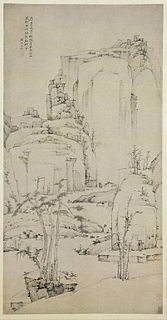 W
WHong Ren, who is also known as Hongren, was a Chinese monk and painter of the early Qing period and a member of the Anhui school of painting. His birth name was Jiang Fang. After the fall of the Ming dynasty he became a monk, as did Zhu Da, Shitao, and Kun Can. They protested the fall of the Ming dynasty by becoming monks. Hong Ren's style has been said to "[represent] the world in a dematerialized, cleansed version ... revealing his personal peace through the liberating form of geometric abstraction."
 W
WHong Yi, born Li Shutong was a Chinese Buddhist monk, artist and art teacher. He also went by the names Wen Tao, Guang Hou, and Shu Tong, but was most commonly known by his Buddhist name, Hong Yi. He was a master painter, musician, dramatist, calligrapher, seal cutter, poet, and Buddhist monk.
 W
WWu Cho Bun was an early 20th-century Chinese painter, famous for painting tigers.
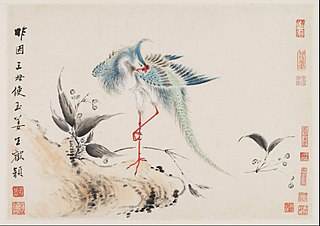 W
WHua Yan simplified Chinese: 华嵒; traditional Chinese: 華嵒; pinyin: Huà Yán; Wade–Giles: Hua Yen; courtesy name Qiu Yue (秋岳), sobriquets Xinluo Shanren (新罗山人), Dong Yuan Sheng (东园生), Buyi Sheng (布衣生), Ligou Jushi (离垢居士)and Bosha Daoren (白沙道人) was a Qing Dynasty Chinese painter. He was born in Shanghang (上杭) Fujian province and lived in Yangzhou and later in Hangzhou. Yan's work is within the tradition of the Yangzhou school and is often named as one of the Eight Eccentrics of Yangzhou.
 W
WHuang Yi (1744-1801), a.k.a. Da Yi; Qiu An; Xiao Song was a painter and seal carver during the Qing dynasty.
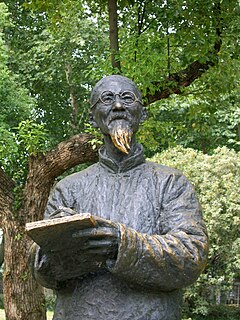 W
WHuáng Bīnhóng was a Chinese literati painter and art historian born in Jinhua, Zhejiang province. His ancestral home was She County, Anhui province. He was the grandson of artist Huang Fengliu. He would later be associated with Shanghai and finally Hangzhou. He is considered one of the last innovators in the literati style of painting and is noted for his freehand landscapes.
 W
WHuang Shen (1687–1772) was a Chinese painter during the Qing Dynasty. Huang was born in Ninghua, Fujian province, to a poor family. His courtesy names were Gongshou (恭壽) and Gongmao (恭懋). His pseudonym was Yingpiaozi (癭瓢子).
 W
WJiang Tingxi, courtesy name Yangsun (杨孙), was a Chinese painter, and an editor of the encyclopedia Gujin Tushu Jicheng.
 W
WJiāo Bǐngzhēn, 1689–1726) was a native of Jining, Shandong who became a noted painter and astronomer. In painting he is noteworthy as one of the first Qing dynasty painters to be influenced by the West. He is also among the more significant portrait and miniature painters in the early Qing. He was skilled in painting people, landscapes, and buildings.
 W
WBorn in 1687 in Hangzhou, Jin Nong (金農) became popular as a painter and calligrapher while living as a childless widower in Yangzhou in his sixties. His paintings of mei blossoms were in particular demand there. Heralded as one of The Eight Eccentrics of Yangzhou, Jin favored the amateur scholar style. A nonconformist, he generally painted more traditional images laden with symbolism and preserved his independence by selling works in an open market, rather than adopting an individual patron. Later styles included Buddhist imagery. However, Jin was the first artist in the Chinese tradition to paint a large number of self-portraits and did earn money through the patronage of wealthy individuals in Yangzhou who, in addition to buying works, were possible publishers for his numerous writings. Jin probably understood these contradictions as he argued that living off of painting should not be considered dishonorable.
 W
WJu Lian, a native of Panyu (番禺, now Guangzhou, was a Chinese painter in Qing Dynasty. His courtesy name was 'Ancient Spring', and self-given pseudonym 'Old Man of the Divided Mountain'. He was the younger brother of the painter Ju Chao. He was known for his bird-and-flower paintings as well as people and plant-and-insect paintings. He was the teacher of the brothers Gao Jianfu and Gao Qifeng.
 W
WJu Chao, a native of Panyu (番禺, now Guangzhou, was a famed Chinese painter in Qing Dynasty. His courtesy name was Meisheng, and pseudonym Meichao or Guquan. He was the older brother of the painter Ju Lian. He wrote "Poems of Shouxie Shi" and "Yanyu Ci".
 W
WKun Can (髡殘) was a Chinese painter from Hunan who spent most of his life in Nanjing. He became a Chan Buddhist monk at an early age and in Nanjing was abbot of a monastery on Niushou Shan. His style of landscape painting was influenced by Wang Meng and he is one of the Four Monk Masters in the early Qing Dynasty. The others being Zhu Da, Hong Ren, and Shitao. As he was also known as Shi Xi he was at times said to be one of the "Two Shi". Few of Kun Can's works survive.
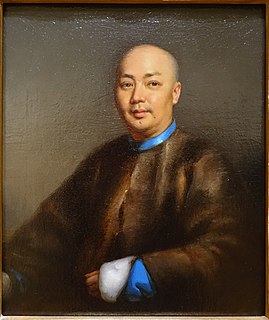 W
WLam Qua, or Kwan Kiu Cheong (關喬昌), was a Chinese painter from the Canton province in Qing Dynasty China, who specialized in Western-style portraits intended largely for Western clients. Lam Qua was the first Chinese portrait painter to be exhibited in the West. He is known for his medical portraiture, and for his portraits of Western and Chinese merchants in Canton and Macau. He had a workshop in 'New China Street' among the Thirteen Factories in Canton.
 W
WLi Shan was a Qing dynasty painter born in Jiangsu. He had an interest in painting at an early age and by 16 was a noteworthy painter. His paintings had an unrestricted quality and were influenced by Shitao. He was one of the Eight Eccentrics of Yangzhou.
 W
WLuo Mu (1622–1706) was a painter, poet and prose writer born in Jiangxi. He spent most of his life in the capital Nanchang. He was noted for his landscape paintings, especially of mountains, and for what would be termed "The JiangXi Style". His personality was said to be convivial and he counted Xu Yuxi amongst his friends.
 W
WLuo Ping was a Chinese painter of the Qing Dynasty who lived in Ganquan (甘泉; present-day Yangzhou, Jiangsu. His courtesy name was Dunfu and his pseudonyms were Liangfeng and Huazhisi Seng. He studied painting under Jin Nong and developed a unique personal style. He painted people, Buddhist images, plum with bamboo, flowers, and scenery paintings. He refused government service to live a life of poverty selling paintings. He was the youngest of the Eight Eccentrics of Yangzhou.
 W
WMin Zhen was a Chinese painter and seal carver born in Nanchang, Jiangxi, who spent most of his life in Hubei. He was noted for painting human figures and doing occasional finger painting. He was orphaned at an early age and is sometimes associated with the Eight Eccentrics of Yangzhou.
 W
WNi Tian, born as Baotian, courtesy name Mogeng, sobriquet as Modaoren and Biyuehezhu, was a Chinese painter in Qing Dynasty and Republic Period.
 W
WOng Schan Tchow alias Yung Len Kwui was born in the ethnically Hokkien city in the eastern part of Longyan prefecture, Southern Fujian Province, China. He was well known for Chinese Ink wash painting and colour paintings of flowers, landscapes, animals, people, still life and Calligraphy. He was regarded as one of the first few batches of Chinese scholars and artists to study in Paris and one of the few artists who integrated both traditional Chinese and Western art techniques. During the Second Sino-Japanese War, he became renowned as a patriot artist when he exhibited extensively in China, Hong Kong and later in South East Asia to raise funds solely for the war relief effort and for the countless Chinese civilian victims in China, Malaysia and Singapore.
 W
WPan Yuliang, born in Yangzhou as Chen Xiuqing, and was renamed Zhang Yuliang (張玉良) when adopted by her maternal uncle after the early passing of her parents. She was a Chinese painter, renowned as the first woman in the country to paint in the Western style. She had studied in Shanghai and Paris. Because her modernist works caused controversy and drew severe criticism in China during the 1930s, Pan returned to Paris in 1937 to live and work for the next 40 years. She taught at the École des Beaux Arts, won several awards for her work, had exhibits internationally in Europe, the United States and Japan, and was collected by major institutions. In 1985 after her death, much of her work was transported to China, collected by the National Art Museum in the capital of Beijing, the larger part are collected by the Anhui Museum in Hefei, the capital of Anhui Province. Nevertheless, significant paintings, sculptures and prints are still conserved in France in the collection of the Cernuschi museum. Her life as an artist has been portrayed in novels and film in China and the United States. Her art evolved within the flux of transformations where conflicting dichotomies of East and West, tradition and modernity, male chauvinism and emerging feminism co-existed. Pan is also figured as who engaged with labels, such as " contemporary/modern," " Chinese," and " woman" artist, while questioning them. Despite being remembered for introducing Western paintings to China, she was able to provide a new lens to how these women were seen through her paintings as not just objects but subjects.
 W
WRen Xiong was a Chinese painter from Xiaoshan, Zhejiang, active during the late Qing dynasty. Ren belonged to the Shanghai School in Chinese painting and is known for his bold and innovative style.
 W
WSpoilum was a Chinese artist active in Guangzhou between 1785 and 1810, during the Old China Trade. He was the earliest oil painter in Canton. He painted portraits of Chinese and Western merchants and sea captains in the Western style painting with oil on canvas rather than ink on paper or silk in the Chinese style. He created paintings of Chinese hong merchants Eshing and Puan Kee Qua. His portraits of Western merchants typically required a two- or three-hour sitting, and cost $10. He also mastered the European technique of reverse glass painting. Little is known of his life, although he was one of a family of painters, including his grandson Lam Qua, and is said to have traveled extensively in the West.
 W
WSunqua was a Chinese painter during the Qing dynasty. He was one of the best known of the Chinese artists in 19th century producing pictures for the European market. Residing in China Street in the city of Canton (Guangzhou), Sunqua worked and established studios in Canton and Macao, and was known for his large oil pictures of the shipping and trade into these ports. His studio also concentrated on flower and trade albums, most of which are in full bodycolour painted on pith paper.
 W
WWang Duo, is a Chinese calligrapher, painter, and poet in Ming dynasty.
 W
WWang Wu ; ca. 1632-1690 was a Chinese painter and poet during the Qing Dynasty (1644–1912).
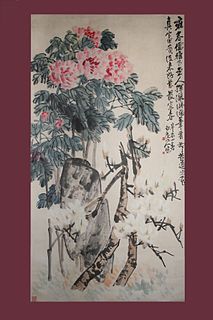 W
WWang Zhen, commonly known by his courtesy name Wang Yiting, was a prominent businessman and celebrated modern Chinese artist of the Shanghai School. He also used the art name Bailong shanren and as a devote Buddhist under other names. He was originally from Wuxing in Zhejiang Province, although spent most of his life in the city of Shanghai where he was a successful businessman-banker. Wang Zhen was a master calligrapher as well as a painter of flowers, birds, personages and Buddhist subjects. He was closely associated with and considered the disciple of the painter Wu Changshuo. It is sometimes said that many of his teacher's paintings were from Wang Zhen himself.
 W
WWu Changshuo, born Wu Junqing, was a prominent painter, calligrapher and seal artist of the late Qing Period.
 W
WXū Gǔ ; ca. (1824–1896) was a Chinese painter and poet during the Qing Dynasty (1644–1912).
 W
WYuan Mei was a Chinese painter and poet of the Qing Dynasty. He was often mentioned with Ji Yun as the "Nan Yuan Bei Ji".
 W
WYun Shouping (惲壽平), also known as Nantian (南田), was a Chinese calligrapher and painter. He was a major artist of the early Chinese Qing dynasty. He was regarded as one of the "Six Masters" of the Qing period, together with the Four Wangs and Wú Lì.
 W
WZhao Zhiqian was a renowned Chinese calligrapher, seal carver and painter in the late Qing Dynasty, "the leading scholar-artist of his day." Zhao's seal carving had profound influence on the later masters, such as Wu Changshuo and Qi Baishi. He is also known under the courtesy name of Yifu (益甫) and his pseudonym (hào) of Lengjun (冷君), which he changed to Huishu (撝叔) and Bei'an (悲盦) respectively later in his life.
 W
WZheng Xie (1693–1765), commonly known as Zheng Banqiao was a Chinese painter from Jiangsu. He began life in poverty, but rose in the exam system to become a magistrate at Shandong. However, after 12 years, he became critical of the life of an official as he refused to ingratiate himself with senior officials. When he was reportedly criticized for building a shelter for the poor, he resigned. After that, he expressed himself in art and became one of the Eight Eccentrics of Yangzhou. He was noted for his drawing of orchids, bamboo, and stones. In 1748 he briefly resumed an official career as "official calligrapher and painter" for the Qianlong Emperor.